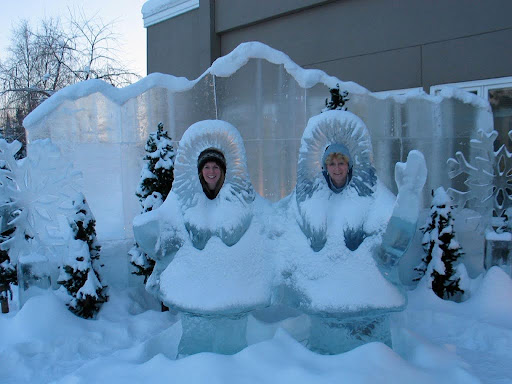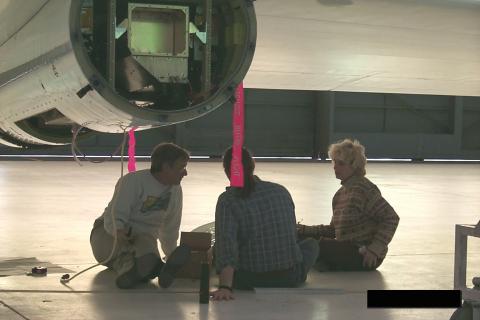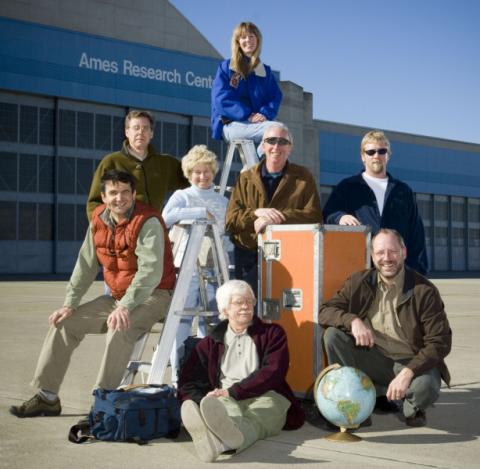By Jane Berg Logo embroidered into the seat covers on the DC-8 jetliner, also known…
In Memory of Sue Tolley (1942–2023)

In this year after Sue Tolley’s passing, we continue to remember and honor her nearly two decades with BAERI as a member of the NASA Earth Science Project Office (ESPO) team.
Marilyn Vasques, Director of ESPO, celebrates her friend and longtime colleague, saying:
I worked and traveled with Sue for many years. Hundreds of deployed scientists and aircraft crew benefited from her detailed organization and care over her 20 years with ESPO. Somehow, she was able to remember everyone’s name and give them personal attention and encourage the team by pointing out the important role ESPO plays. She was also an integral part of the Science Operations Flight Request System for the Airborne Science Program. Sue was a bright and caring person who will be sorely missed.
The following tribute is from Steve Hipskind’s eulogy of Sue, delivered in February of 2023 at a celebration-of-life gathering of her family, friends, and colleagues in Hood River, Oregon.
***
Hi everyone, I’m Steve Hipskind. I was the head of the Earth Science Division at NASA Ames for 11 years before I retired in 2015, but before that, I had the privilege of traveling the world with Sue in service to NASA’s Earth science program.
NASA has a fleet of Earth observing satellites that are constantly monitoring the health of our home planet, but for more in-depth studies of specific phenomena, NASA maintains a fleet of unique aircraft. Sue and I were part of the team that would help load up those aircraft with scientific instruments and chase things around the world, like the ozone hole over Antarctica or hurricanes in the western Atlantic.
I first met Sue in 1989, when she was working for John Arvesen and the High Altitude Missions Branch, which operated the modified U-2 aircraft that was a workhorse for stratospheric observations. When the NASA Ames aircraft were moved down to NASA Armstrong at Edwards Air Force Base in 1997, Sue came to work with us as part of the ESPO team and supported aircraft field campaigns until she retired.
Sue loved the work she did for NASA. She was a rock in the face of the often stressful situations that come up in the field, and she exuded a passion for life and a calm wisdom that put people at ease. Life for her was an adventure and an exploration, and she had a youthful enthusiasm for learning.

I reached out to friends and colleagues to let them know about Sue’s passing. Everyone talked about their joy and appreciation for Sue’s work on every project she touched, as well as her hardworking and calm demeanor. One poignant response came from Emmett Quigley, a master machinist and metal worker, who in addition to supporting many of ESPO’s campaigns, has actually built spacecraft that were recently launched into space. Emmett’s comment was, “Sue was an amazing person who helped me be a better person—and a better technician.” I told him that Sue had that effect on a lot of people, including me.
Sue worked for BAERI for most of the time that she worked for ESPO. Bob Bergstrom, who started BAERI and who hired Sue, said she was “truly one of the good people,” high praise from someone known for an economy of words.
Estelle Condon, who is in the NASA Ames Hall of Fame and who started ESPO with the first ozone-hole mission out of Punta Arenas, Chile, in 1987, said of Sue: “I loved working with Sue! She was smart, funny, kind, and so hardworking. She was very supportive of me and the work we needed to do. She was one of a kind, and her passing has left a hole in many of our hearts.”

Sue had some memorable adventures during ESPO’s field campaigns. One that stands out was the winter she and her husband John Chesterman, along with ESPO’s Mike Craig and Quincy Allison, spent in Fairbanks, Alaska, building temporary science labs at Fort Wainwright. Temperatures hit 50 degrees below zero, but they were treated to amazing displays of the aurora borealis almost every night.
Then there was the mission above the Arctic Circle in Kiruna, Sweden. Sue, John, Mike, and Quincy and I did a major circumnavigation on snow machines of the mountainous countryside around Kiruna, hitting speeds of over 60 mph on snow-covered rivers, then ended with a reindeer dinner cooked at a local indigenous Sámi farm.
One adventure Sue had on her own was during the mission we did in the hinterland in sub-Amazonian Brazil. Most of us flew on commercial flights, which took us from the US to Rio de Janeiro at night, so we didn’t get to see any of the countryside. But for this campaign, ESPO used an Air Force C-5 transport aircraft to move all of our scientific support equipment to Brazil. Sue flew down during daylight hours on the C-5, and Sue being Sue, she was invited to sit up front in the spacious cockpit. Unlike the rest of us, she got to see Brazil, and particularly the Amazon, in all its glory. That flight inspired her to take some time off after the mission and stay in a treetop lodge in Manaus, where the upper Amazon merges with the Rio Negro. She always said that that was one of her most memorable travel experiences.
Sue was an absolute joy to have had as a colleague and a friend. We should all feel grateful in knowing that she led such a full and impactful life that touched the hearts and souls of all who knew her.

* * *
If you would like to add your own memory of Sue or send a condolence to her family, you can contribute a post to her memory wall here.
Go here to view a video slideshow that captures Sue’s time with the ESPO team



